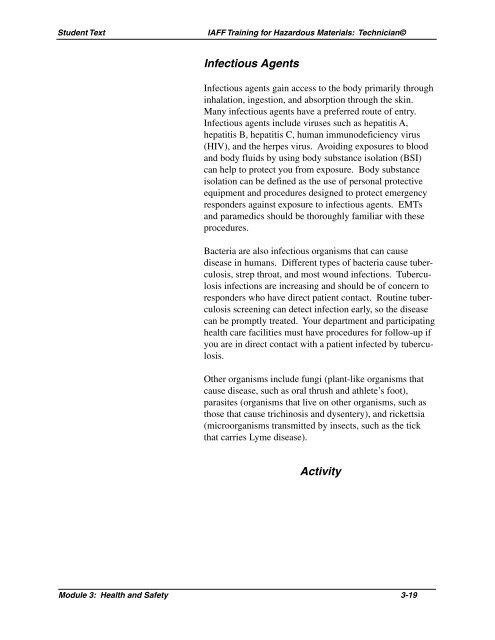Module 3: Health and Safety - IAFF
Module 3: Health and Safety - IAFF
Module 3: Health and Safety - IAFF
Create successful ePaper yourself
Turn your PDF publications into a flip-book with our unique Google optimized e-Paper software.
Student Text <strong>IAFF</strong> Training for Hazardous Materials: Technician©<br />
Infectious Agents<br />
Infectious agents gain access to the body primarily through<br />
inhalation, ingestion, <strong>and</strong> absorption through the skin.<br />
Many infectious agents have a preferred route of entry.<br />
Infectious agents include viruses such as hepatitis A,<br />
hepatitis B, hepatitis C, human immunodeficiency virus<br />
(HIV), <strong>and</strong> the herpes virus. Avoiding exposures to blood<br />
<strong>and</strong> body fluids by using body substance isolation (BSI)<br />
can help to protect you from exposure. Body substance<br />
isolation can be defined as the use of personal protective<br />
equipment <strong>and</strong> procedures designed to protect emergency<br />
responders against exposure to infectious agents. EMTs<br />
<strong>and</strong> paramedics should be thoroughly familiar with these<br />
procedures.<br />
Bacteria are also infectious organisms that can cause<br />
disease in humans. Different types of bacteria cause tuberculosis,<br />
strep throat, <strong>and</strong> most wound infections. Tuberculosis<br />
infections are increasing <strong>and</strong> should be of concern to<br />
responders who have direct patient contact. Routine tuberculosis<br />
screening can detect infection early, so the disease<br />
can be promptly treated. Your department <strong>and</strong> participating<br />
health care facilities must have procedures for follow-up if<br />
you are in direct contact with a patient infected by tuberculosis.<br />
Other organisms include fungi (plant-like organisms that<br />
cause disease, such as oral thrush <strong>and</strong> athlete’s foot),<br />
parasites (organisms that live on other organisms, such as<br />
those that cause trichinosis <strong>and</strong> dysentery), <strong>and</strong> rickettsia<br />
(microorganisms transmitted by insects, such as the tick<br />
that carries Lyme disease).<br />
Activity<br />
<strong>Module</strong> 3: <strong>Health</strong> <strong>and</strong> <strong>Safety</strong> 3-19
















